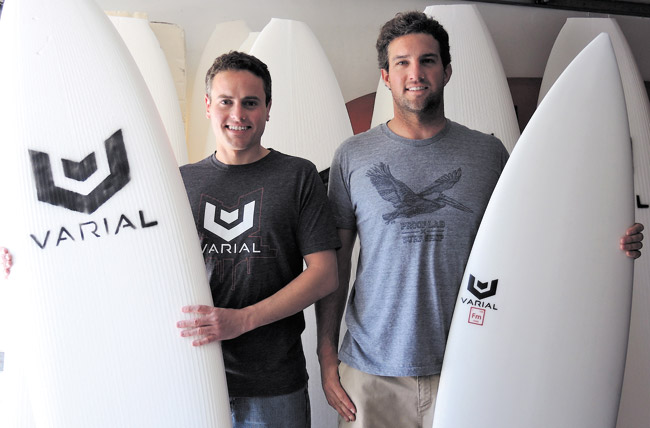Technologically Advanced Surfboards
It’s not rocket science — or is it? The world of surfing is on the verge of taking off to new heights, thanks to science, technology and a little help from the aerospace industry.
California-based Varial Surf Technology has developed a new surfboard foam material that is lighter, stronger and more flexible than anything in the ocean.
The stronger foam means fewer broken boards and more time in the lineup.
“We started developing this foam a little less than two years ago,” says Varial Surf Technology CEO and company co-founder Parker Borneman. “We went to market about nine months ago with shapers on the West Coast, and have been working hard to improve the product until it was absolutely perfect. We were ready to come to Oahu’s North Shore for the winter surf season!”
Borneman grew up in Santa Barbara, where he and his lifelong friend Edison Conner spent thousands of hours surfing California waters. But, like many other surfers, they too were frustrated with broken boards and a lack of new technology.
It was the catalyst to the company’s inception in 2005.
But before they combined their talents, Conner worked as an engineer designing and manufacturing rocket parts. Together, he and Borneman spent years working with aerospace and motorsports companies to perfect their high-performance foam cores.
“The formula will revolutionize surfing,” claims Borneman. “The foam is so rigid and strong, we don’t need additional support or materials to increase strength. It’s a pure piece of foam with no wood stringers. The boards are 25 percent stronger, 20 percent lighter.”
Borneman says the foam is easier to manufacture and can be glassed with polyester or epoxy resin, and unlike other foams, Varial Foam cores will never yellow in the sun.
He says, so far, they’ve received positive feedback from those who’ve ridden surf-boards made with the foam. He says some of the biggest names in surfing have used Varial surf-boards, including 11-time world champion Kelly Slater.
“The foam holds firm and directs the energy into flexing the board and pushing against the water,” explains Borneman.
“When surfers come out of their turns, all that energy is released back into the water.”
The end result is faster, more controlled surfing.
Borneman and his team recently spent two weeks in Hawaii testing the product with professional surfers and local shapers in the winter surf. He says it was the perfect opportunity to have a captive audience, with the best surfers and shapers in the word visiting the North Shore.
“There’s no better place in the world and no better time to prove our technology with the best surfers in the most challenging waves,” says Borneman. “Most of the surfers have given us the thumbs up, and the shapers who’ve made the boards are really excited about the product as well. We’re very pleased.”
Borneman expects the foam will be widely available for shortboards all the way up to 8-foot guns by February or March. He says although they have not developed a foam core for standup boards, it may be on the horizon. Surfers can expect to pay about $150 to $200 more per board. The tradeoff is a better-performing board that will last longer.
“We believe it’s a better experience for any level surfer, not just the pros,” Borneman says. “It seems like novice and amateur users have a lot more fun.”
Or as the company describes it: “The closest analogy is the switch from driving a slushy old Ford suspension to a tight and responsive BMW.”
For more information on the new surfing technology, go to varialsurf.com.
rkmizutani@gmail.com






